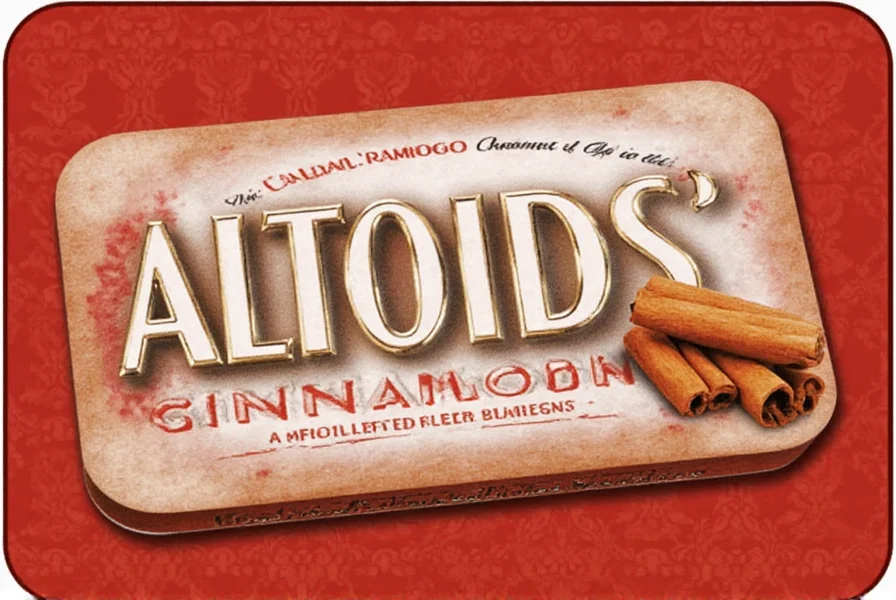Altoids Cinnamon mints have maintained a distinctive presence in the breath mint market since their introduction. Unlike standard mints that offer subtle refreshment, these small, white discs deliver an intense flavor experience that has cultivated a dedicated following among consumers seeking powerful oral refreshment and traditional digestive support.
Understanding Altoids Cinnamon Composition
What sets Altoids Cinnamon apart from other breath mints is their specific formulation. The mints contain a higher concentration of natural oils compared to standard mint varieties, creating that signature intense sensation that starts mild but builds to a noticeable warmth.
| Key Ingredient | Percentage | Function |
|---|---|---|
| Sugar | 85% | Base sweetener and structural component |
| Corn Syrup | 10% | Binding agent and texture modifier |
| Natural Oil of Cinnamon | 3.5% | Primary flavoring agent creating the distinctive heat |
| Other Natural Flavors | 1.5% | Supporting flavor notes and complexity |
The precise formulation of Altoids Cinnamon contributes to their characteristic flavor progression. When consumed, the initial sweetness gives way to a building warmth that peaks around 30-45 seconds after consumption, then gradually subsides while maintaining breath-freshening properties for up to 45 minutes.
Historical Background of Cinnamon Altoids
While Altoids originated in England in 1784 as "lozenges for the throat," the cinnamon variety emerged much later as consumer preferences evolved. The brand was acquired by Cadbury in 1956, which expanded the product line beyond the original peppermint formula.
The introduction of Altoids Cinnamon in the late 20th century responded to growing consumer interest in stronger, more distinctive flavors. Unlike the medicinal origins of the peppermint variety, cinnamon Altoids gained popularity for both their breath-freshening capabilities and traditional use for digestive discomfort.

Practical Applications Beyond Breath Freshening
While marketed primarily as breath mints, Altoids Cinnamon have developed a reputation for several practical applications that extend beyond oral refreshment. Outdoor enthusiasts often include them in emergency kits due to their long shelf life and compact packaging.
Many consumers report using Altoids Cinnamon for traditional digestive support, particularly during travel or after meals. The warming sensation created by the cinnamon oil has been part of folk remedy practices for generations, though scientific evidence supporting specific health benefits remains limited.
Campers and hikers appreciate these mints for multiple reasons: their metal tins provide protection from crushing, the mints themselves resist melting in warm temperatures better than chocolate-based alternatives, and the strong flavor can help mask unpleasant outdoor odors.
Comparing Altoids Varieties
Understanding the differences between Altoids varieties helps consumers select the appropriate product for their needs. While all Altoids share the distinctive metal tin packaging and similar physical characteristics, the flavor profiles vary significantly.
Altoids Cinnamon delivers a building warmth that intensifies after initial consumption, whereas Altoids Peppermint provides immediate cooling that gradually diminishes. This fundamental difference in sensory experience makes each variety better suited for specific situations and personal preferences.
For those seeking the most intense experience, Wintergreen Altoids offer a different kind of strong sensation, while Spearmint provides a milder alternative. The cinnamon variety remains unique in creating that distinctive warming progression that has become its signature characteristic.
Consumer Experience and Flavor Perception
Individual responses to Altoids Cinnamon vary based on personal tolerance for strong flavors and previous exposure to intense mints. First-time users often experience surprise at the building intensity, while regular consumers appreciate the predictable flavor progression.
The metal tins serve a practical purpose beyond branding—they protect the mints from moisture and physical damage while preserving flavor integrity. This packaging choice contributes significantly to the product's shelf stability and portability, making Altoids Cinnamon suitable for inclusion in emergency kits, purses, and outdoor gear.

Responsible Consumption Guidelines
Due to their intense flavor profile, Altoids Cinnamon should be consumed with awareness of their strength. Most consumers find that one mint provides sufficient flavor duration, with additional mints potentially causing oral discomfort.
Individuals with sensitive mouths, recent dental work, or certain medical conditions should exercise caution when trying these strong mints for the first time. The high sugar content also warrants consideration for those monitoring their sugar intake, though sugar-free alternatives are available from some manufacturers.
Frequently Asked Questions
What makes Altoids Cinnamon different from regular cinnamon mints?
Altoids Cinnamon contains a higher concentration of natural cinnamon oil (approximately 3.5%) compared to standard cinnamon mints, creating a distinctive flavor progression that starts mild but builds to noticeable warmth. The precise formulation and traditional manufacturing process result in a longer-lasting, more intense experience than typical cinnamon-flavored mints.
Why do Altoids Cinnamon mints create a warming sensation?
The warming sensation comes from cinnamaldehyde, the primary compound in natural cinnamon oil. Unlike cooling agents in peppermint, cinnamaldehyde stimulates thermoreceptors in the mouth, creating a sensation of warmth that builds over 30-45 seconds after consumption. This physiological response is why many people associate cinnamon flavors with warmth and comfort.
Are Altoids Cinnamon mints effective for nausea relief?
While not medically proven for nausea treatment, many consumers report that Altoids Cinnamon provides traditional digestive support. The strong flavor and warming sensation may help distract from feelings of nausea for some individuals. However, they should not replace medical treatment for persistent nausea or digestive issues.
How should I store Altoids Cinnamon to maintain freshness?
The metal tin provides excellent protection, but for maximum shelf life (typically 18-24 months), store Altoids Cinnamon in a cool, dry place away from direct sunlight. Avoid humid environments as moisture can cause the mints to stick together. The tight-sealing tin helps preserve flavor integrity when kept closed between uses.











 浙公网安备
33010002000092号
浙公网安备
33010002000092号 浙B2-20120091-4
浙B2-20120091-4